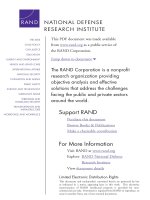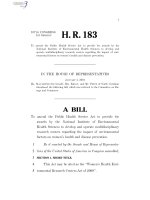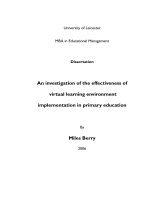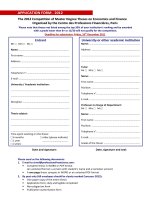INVESTIGATION OF THE EFFECT OF THE DIFFERENT FACTORS ON THE STAR POLYACRYLATE PREPARATION BY ATRP METHOD
Bạn đang xem bản rút gọn của tài liệu. Xem và tải ngay bản đầy đủ của tài liệu tại đây (3.23 MB, 43 trang )
INVESTIGATION OF THE EFFECT
OF THE DIFFERENT FACTORS ON THE
STAR-POLYACRYLATE PREPARATION
BY ATRP METHOD
SUPERVISOR : Assoc.Prof.Dr. NGUYEN CUU KHOA
STUDENT : PHAM THI MINH DIEU
Contents
Literature review
What is ATRP?
Free radical polymerization:
Controlled/living radical polymerization
Atom transfer radical polymerization (ATRP) based on a
transition metal halide/ nitrogen based ligand catalyst.
•
A synthesis route for a wide variety of different
polymers and material composites.
•
Poorly controlled, high molecular weights, high
PDI and poorly defined products.
A wide variety of monomers have been used to
synthesize polymers by ATRP with predetermined
molecular weight and functional end group.
I. Literature review
Atom transfer radical polymerization (ATRP)
Components of ATRP
•
Monomer: styrene, acrylate , methacrylate
•
Initiator: alkyl halide such as aryl, carbonyl,…
•
Catalyst :
- Transition metal : Cu, Fe, Ni, Ru,
- Nitrogen based ligand : bpy, TEPA, PMDETA, …
•
Additives
I. Literature review
Processes in normal ATRP
R-X + M
t
n
Y/L
m
R
+ XM
t
n+1
Y/L
m
R
+ M
R-M
Initiation
R
+
R M M
( )
n
M
nM
Propagation:
Reversible termination:
R M M
(
)
n
+
XM
t
n+1
Y/L
m
R M M
(
)
n
X
+
M
t
n
Y/L
m
I. Literature review
ATRP’s features
•
Long-lived polymer chains
gradient, block and graft copolymers
•
Predetermined molecular weight
•
Halogen end group transformation
•
Narrow polydispersity
•
First-order kinetics
behavior
I. Literature review
Polymeric materials made by ATRP
I. Literature review
State of art ATRP research
I. Literature review
Suresh K. Jewrajka and Broja M. Mandal (2003) studied the
ATRP of acrylamide in water or in glycerol-water 2-Cl-PA or 2-
Br-PA and CuX bipyridine complex as catalyst. The ln Mo/M vs t
plots are curved to start with but become linear The chain
extension experiment confirms the living nature of the polymers
Huiqi Zhang, Bert Klumperman (2006) investigated the
kinetics of CuBr-mediated homogeneous ATRP of MMA using as
NHBMI ligand and HEBIB as initiator. When ≤10% Cu(II)
relative to Cu(I) was added, the ln([M]0/[M] ~ (t2/3) . When
[Cu(II)]0 >10%, ln([M]0/[M] ~ t; Rp ~ [initiator], [Cu(I)] and
[Cu(II)]-1 . Keq and kt were determined to be 7.2 × 10-8 and 8.9
× 107 M-1 s-1
State of art ATRP research
I. Literature review
K. A. Davis, H. Paik, and K. Matyjaszewski (1999) investigated
the dependence of Rp on the concentrations of initiator, catalyst,
Cu(II), and temperature of MA using dNbpy as the catalyst and
MBrP as the initiator. Keq=1.2 × 10-9 at 90°C, ΔHapp = 27.5
kcal/mol. With CuPF6/dNbpy catalyst, kapp was approximately 40
times that of the corresponding CuBr/dNbpy catalyzed reaction and
ΔHapp = 10.3 kcal/mol.
K. Matyjaszewski and Jianhui Xia (1997) investigated the ATRP
of styrene employing a CuX/dNbpy catalyst and RX initiators, was
first order with respect to monomer, initiator, and Cu(I)
concentrations. The relationship between kapp and Cu(II) shows a
decay behavior. The fastest polymerization rate was observed with a
ratio of ligand to metal of 2:1.
State of art ATRP research
I. Literature review
In Vietnam, Tran Huu Nghi and Nguyen Thi Hanh, et.al
(2010) synthesized star-poly(methyl acrylate) by ATRP with
triglyceride 2-bromopropionate as initiator and the complex
CuBr/TEPA as catalyst. Poly(Methyl acrylate) are attached to
the APTES modified silica particles to make hybrid material.
Objective
Synthesize the star-polyacrylate of n-butyl acrylate, n-octyl
acrylate using triglyceride 2-bromopropionate as a initiator and
CuBr/TEPA as a catalyst.
Investigate the effect of different factors such as ligands,
monomers, additives… on the star-poly( methyl acrylate)
synthesis by ATRP.
I. Experimental section
Polymerization
Preparation of CuBr, CuBr2, Triglyceride 2-bromopropionate
and n-octyl acrylate
Synthesizing star-polyacrylates
Investigation
The effect of ligands, chain length of monomers and additives
Kinetic studies of ATRP
The living nature of the polymers
II. Experimental section
POLYMERIZATION
Monomers
Initiator
Catalyst
Additives
Cu
CuBr
2
Methyl acrylate
n-Butyl acrylate
n-Octyl acrylate
Triglyceride 2-
bromopropionate
Ligands CuBr
INVESTIGATION
TEPA PMDETA
The
effect of
ligands,
monomer
additives
Kinetic
studies
“Living”
nature
Preparation
CuBr, CuBr2
The initiator (triglyceride 2-bromopropionate) was
synthesized by esterification of 2-bromopropionic
acid and glycerol in microwave oven
n-Octyl alcohol and acrylic acid were esterified in
microwave oven in presence of H2SO4 as catalyst and
hydroquinone as inhibitor
II. Experimental section
II. Experimental section
2-Bromopropionic
acid (9ml)
Glycerol (2.2ml)
Esterification
Wash
Purify
Initiator
H2SO4c
In
microwave
180W,
10min
Column
chromatography
Chloroform : n-hexan
= 4 : 1
H2O, NaHCO3
Initiator Triglyceride
Triglyceride
CuBr +TEPA
or PMDETA
Polymerization
T=80oC
Remove catalyst
Polymers
Complex formation
Monomer
30min
N2 atmosphere
NP9
Polymerization
HCl 5%
II. Experimental section
The effect on reaction time
Substances Quantity
Molecule
(mmol)
Molar
ratio
Initiator 0.26ml 0.75 1
CuBr 0.108g 0.75 1
TEPA 0.22ml 1.5 2
MA 2.03ml 22.5 30
Substances Quantity
Molecule
(mmol)
Molar
ratio
Initiator 0.26ml 0.75 1
CuBr 0.108g 0.75 1
TEPA 0.22ml 1.5 2
nBA 3.2ml 22.5 30
Substances Quantity
Molecule
(mmol)
Molar
ratio
Initiator 0.26ml 0.75 1
CuBr 0.108g 0.75 1
TEPA 0.22ml 1.5 2
nOA 4.7ml 22.5 30
[I]/[CuBr]/[TEPA]/[M] =1:1:2:30
Monomers:
Methyl acrylate
n-Butyl acrylate
n-Octyl acrylate
II. Experimental section
The effect on reaction time
Ligands:
Tetraethylenepentamine (TEPA)
Pentamethyldiethylenetriamine (PMDETA)
Set I (mol)
CuBr
(mol)
Cu
(mol)
CuBr2
(mol)
MA
(mol)
TEPA
(mol)
PMDETA
(mol)
(1) 0.018 0.009 0 0.009 10.08 0.072 0
(2) 0.019 0.009 0 0.009 10.64 0 0.073
(3) 0.018 0.018 0 0 10.08 0.072 0
(4) 0.018 0.018 0 0 10.84 0 0.072
(5) 0.018 0.009 0.009 0 10.27 0.07
(6) 0.018 0.009 0.009 0 10.87 0.072
The molar ratio [I]/[CuI] +[CuII]/[L]/[MA] = 1:1:4:600
II. Experimental section
Kinetic studies of ATRP
The ATRP of MA using CuBr/PMDETA as a catalyst
Substances Quantity Mole Molar ratio
Initiator 0.34ml
1×10-3
1
CuBr 0.072g
0.5×10-3
0.5
Cu 0.032g
0.5×10-3
0.5
PMDETA 0.835ml
4×10-3
4
MA
54ml 0.6 600 (10)
27ml 0.3 300 (11)
18ml 0.2 200 (12)
Substances Quantity Mole Molar ratio
Initiator 0.34ml 1×10-3 1
CuBr 0.144g 1×10-3 1
PMDETA 0.835ml 4×10-3 4
MA
54ml 0.6 600 (7)
27ml 0.3 300 (8)
18ml 0.2 200 (9)
Substances Quantity Mole Molar ratio
Initiator 0.34ml
1×10-3
1
CuBr 0.072g
0.5×10-3
0.5
CuBr2 0.112g
0.5×10-3
0.5
PMDETA 0.835ml
4×10-3
4
MA
54ml 0.6 600 (13)
27ml 0.3 300 (14)
18ml 0.2 200 (15)
At regular time intervals , the samples were withdrawn
to determine the monomer conversion
II. Experimental section
The “living” nature of the polymers
Substances Quantity Molecule
(mmol)
Molar ratio
Initiator 0.26ml 0.75 1
CuBr 0.108g 0.75 1
TEPA 0.22ml 1.5 2
MA 2.03ml 22.5 30
1.92ml 21.3 60
1.85ml 20.5 90
The polymers produced in a three-stage monomer addition
experiment (Cu or CuBr2 as additives)
Substances Quantity Molecule
(mmol)
Molar ratio
Initiator 0.26ml 0.75 1
CuBr 0.054g 0.375 0.5
Cu 0.024g 0.375 0.5
TEPA 0.22ml 1.5 2
MA 2.03ml 22.5 30
1.92ml 21.3 60
1.85ml 20.5 90
Substances Quantity
Molecule
(mmol)
Molar ratio
Initiator 0.26ml 0.75 1
CuBr 0.054g 0.375 0.5
CuBr2 0.084g 0.375 0.5
TEPA 0.22ml 1.5 2
MA 2.03ml 22.5 30
1.92ml 21.3 60
1.85ml 20.5 90
After each stage reaction, 0.2g of the solution was withdrawn
to analyze by GPC
II. Experimental section
III. Results & Conclusion
CuBr2CuBr
Polyacrylate
Initiator:Triglyceride
1H-NMR spectra of poly(n-butyl acrylate)
CHOCOCH
CH
3
CH
HCOCOH
2
C
HCOCOH
2
C
COOCH
2
CH
2
CH
2
CH
3
CH
2
Br
n
CH
3
CH
CH
3
CH
COOCH
2
CH
2
CH
2
CH
3
CH
2
COOCH
2
CH
2
CH
2
CH
3
CH
2
Br
Br
(4b)
(5b)
(6b)
(7b)
(1b)
(2b)
(3b)
n
n
4b
2b
Sol
7b
6b
5b
III. Results & Conclusion
13C-NMR spectra of poly(n-butyl acrylate)
CHOCOCH
CH
3
CH
HCOCOH
2
C
HCOCOH
2
C
COOCH
2
CH
2
CH
2
CH
3
CH
2
Br
n
CH
3
CH
CH
3
CH
COOCH
2
CH
2
CH
2
CH
3
CH
2
COOCH
2
CH
2
CH
2
CH
3
CH
2
Br
Br
(4b)
(5b)
(6b)
(7b)
(1b)
(2b)
(3b)
n
n
7b
6b
3b
5b
2b
4b
1b
sol
III. Results & Conclusion
sol
13C-NMR DEPT of poly(n-butyl acrylate)
13C-NMR
DEPT135
DEPT90
CHOCOCH
CH
3
CH
HCOCOH
2
C
HCOCOH
2
C
COOCH
2
CH
2
CH
2
CH
3
CH
2
Br
n
CH
3
CH
CH
3
CH
COOCH
2
CH
2
CH
2
CH
3
CH
2
COOCH
2
CH
2
CH
2
CH
3
CH
2
Br
Br
(4b)
(5b)
(6b)
(7b)
(1b)
(2b)
(3b)
n
n
III. Results & Discussion
1H-NMR spectra of poly(n-octyl acrylate)
CHOCOCH
CH
3
CH
HCOCOH
2
C
HCOCOH
2
C
COOCH
2
CH
2
(CH
2
)
5
CH
3
CH
2
Br
n
CH
3
CH
CH
3
CH
COOCH
2
CH
2
(CH
2
)
5
CH
3
CH
2
COOCH
2
CH
2
(CH
2
)
5
CH
3
CH
2
Br
Br
(4c)
(5c)
(6c)-(10c)
(1c)
(2c)
(3c)
n
n
(11c)
4c
sol
2c
11c
5c
6c-10c
III. Results & Discussion









